
Home - Search - Browse - Alphabetic Index: 0- 1- 2- 3- 4- 5- 6- 7- 8- 9
A- B- C- D- E- F- G- H- I- J- K- L- M- N- O- P- Q- R- S- T- U- V- W- X- Y- Z
Nimbus
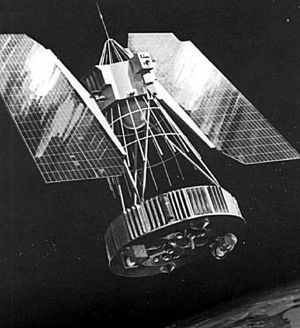 Nimbus Credit: NASA |
Status: Operational 1964. First Launch: 1964-08-28. Last Launch: 1978-10-24. Number: 8 . Gross mass: 907 kg (1,999 lb).
The Nimbus Technology satellite program was initiated by NASA in the early 1960's to develop an observational system capable of meeting the research and development needs of Earth scientists. The objectives of the program were to: develop advanced passive radiometric and spectrometric sensors for surveillance of the atmosphere and oceans; develop and evaluate new active and passive sensors for sounding the atmosphere and for mapping surface characteristics; develop advanced space technology and ground data processing techniques for meteorological and scientific research; and participate in global observation programs such as the World Weather Watch (WWW). Eight spacecraft were built, of which 7 were launched, with one failure, between 1964 and 1978. The Nimbus satellites were placed in polar orbits and acquired global data twice every 24 hours.
Nimbus were second-generation meteorological research-and-development satellites that was designed to serve as a stabilized, earth-oriented platform for the testing of advanced meteorological sensor systems and for collecting meteorological data. The polar-orbiting spacecraft consisted of three major elements: (1) a sensory ring, (2) solar paddles, and (3) the control system housing. The solar paddles and the control system housing were connected to the sensory ring by a truss structure, giving the satellite the appearance of an ocean buoy. Nimbus, depending on the experiments carried, was 3.04 to 3.7 m tall, 1.52 m in diameter at the base, and 3 to 3.96 m across with solar paddles extended. The sensory ring, which formed the satellite base, housed the electronics equipment and battery modules. The lower surface of the torus-shaped sensory ring provided mounting space for sensors and telemetry antennas. An H-frame structure mounted within the center of the torus provided support for the larger experiments and tape recorders. Mounted on the control system housing, which was located on top of the spacecraft, were sun sensors, horizon scanners, gas nozzles for attitude control, and a command antenna. Use of a stabilization and control system allowed the spacecraft's orientation to be controlled to within plus or minus 1 degree for all three axes (pitch, roll, and yaw). Sensors carried varied by mission.
More at: Nimbus.
| Nimbus B, 3 Meteorology, experimental satellite built by RCA Astrospace for NASA, NOAA, USA. Launched 1968 - 1969. Used Nimbus Bus. |
| Nimbus 4 Meteorology, experimental satellite built by RCA Astrospace for NASA, NOAA, USA. Launched 1970. Used Nimbus Bus. |
| Landsat 1-2-3 American earth land resources satellite. The first 3 Landsat missions were also known as the Earth Resources Technology Satellite (ERTS) series. Earth Observing satellite built by RCA Astro Space for NASA, USA. Launched 1972 - 1978. Used Nimbus Bus. |
| Nimbus 5 Meteorology, experimental satellite built by RCA Astrospace for NASA, NOAA, USA. Launched 1972. Used Nimbus Bus. |
| Nimbus 6 Meteorology, experimental satellite built by RCA Astrospace for NASA, NOAA, USA. Launched 1975. Used Nimbus Bus. |
| Nimbus 7 Meteorology, experimental satellite built by RCA Astrospace for NASA, NOAA, USA. Launched 1978. Used Nimbus Bus. |
Family: Earth, Earth weathersat, Sun synchronous orbit. Country: USA. Launch Vehicles: Thor, Delta, Thor SLV-2A Agena B, Thor SLV-2 Agena B, Thorad SLV-2G Agena D, Delta 0900, Delta 2910, Delta 0100, Delta 2000. Launch Sites: Vandenberg, Vandenberg SLC2E, Vandenberg SLC2W. Agency: NASA. Bibliography: 126, 2, 297, 3966, 3967, 3968, 3969, 3970, 3971, 3972, 3973, 3974, 3975, 6, 6737, 12880, 12881, 12882, 12883, 12884, 12885.
 | Nimbus Credit: NASA |
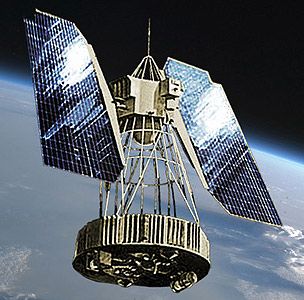 | Nimbus 1 Credit: Manufacturer Image |
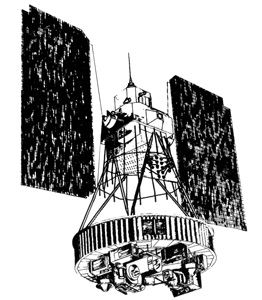 | Nimbus 4 Credit: Manufacturer Image |
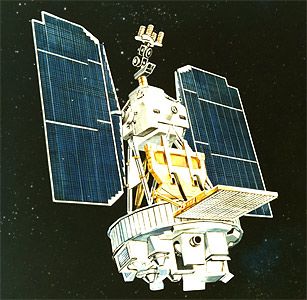 | Nimbus 5 Credit: Manufacturer Image |
 | Nimbus 6 Credit: Manufacturer Image |
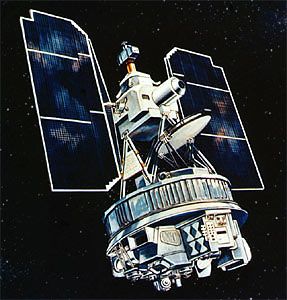 | Nimbus 7 Credit: Manufacturer Image |
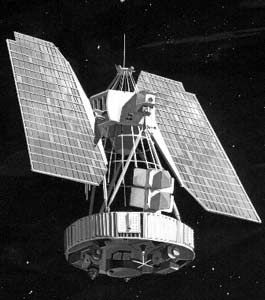 | Nimbus B Credit: Manufacturer Image |
1964 August 28 - . 07:56 GMT - . Launch Site: Vandenberg. Launch Complex: Vandenberg SLC2E. LV Family: Thor. Launch Vehicle: Thor SLV-2 Agena B. FAILURE: Agena-B cut off too early. Partial Failure.. Failed Stage: U.
- Nimbus 1 - .
Payload: Nimbus A. Mass: 376 kg (828 lb). Nation: USA.
Agency: NASA Greenbelt.
Class: Earth.
Type: Weather satellite. Spacecraft: Nimbus.
Decay Date: 1974-05-16 . USAF Sat Cat: 872 . COSPAR: 1964-052A. Apogee: 937 km (582 mi). Perigee: 429 km (266 mi). Inclination: 98.70 deg. Period: 98.40 min.
An Air Force Thor/Agena B was launched from Vandenberg and placed NASA's first Nimbus meteorological satellite into orbit. Returned 27,000 cloud cover images. The spacecraft carried an advanced vidicon camera system for recording and storing remote cloudcover pictures, an automatic picture transmission camera for providing real-time cloud cover pictures, and a high-resolution infrared radiometer to complement the daytime TV coverage and to measure nighttime radiative temperatures of cloud tops and surface terrain. A short second-stage burn resulted in an unplanned eccentric orbit. Otherwise, the spacecraft and its experiments operated successfully until September 22, 1964. The solar paddles became locked in position, resulting in inadequate electrical power to continue operations.
1966 May 15 - . 07:55 GMT - . Launch Site: Vandenberg. Launch Complex: Vandenberg SLC2E. LV Family: Thor. Launch Vehicle: Thor SLV-2A Agena B.
- Nimbus 2 - .
Payload: Nimbus C. Mass: 414 kg (912 lb). Nation: USA.
Agency: NASA Greenbelt.
Class: Earth.
Type: Weather satellite. Spacecraft: Nimbus.
USAF Sat Cat: 2173 . COSPAR: 1966-040A. Apogee: 1,176 km (730 mi). Perigee: 1,093 km (679 mi). Inclination: 100.30 deg. Period: 108.00 min.
The last Thrust Augmented Thor/Agena B was used to place NASA's NIMBUS II meteorological satellite into orbit. TV, IR cloud cover photos. The spacecraft carried an advanced vidicon camera system for recording and storing remote cloud cover pictures, an automatic picture transmission camera for providing real-time cloudcover pictures, and both high- and medium-resolution infrared radiometers (HRIR and MRIR) for measuring the intensity and distribution of electromagnetic radiation emitted by and reflected from the earth and its atmosphere. The spacecraft and experiments performed normally after launch until July 26, 1966, when the spacecraft tape recorder failed. Its function was taken over by the HRIR tape recorder until November 15, 1966, when it also failed. Some real-time data were collected until January 17, 1969, when the spacecraft mission was terminated owing to deterioration of the horizon scanner used for earth reference.
1968 May 18 - . 08:23 GMT - . Launch Site: Vandenberg. Launch Complex: Vandenberg SLC2E. LV Family: Thor. Launch Vehicle: Thorad SLV-2G Agena D. FAILURE: Failure. Failed Stage: U.
- Nimbus B - . Mass: 570 kg (1,250 lb). Nation: USA. Agency: NASA. Class: Earth. Type: Weather satellite. Spacecraft: Nimbus. Decay Date: 1968-05-18 . Nimbus B2 meteorological satellite..
1969 April 14 - . 07:54 GMT - . Launch Site: Vandenberg. Launch Complex: Vandenberg SLC2E. LV Family: Thor. Launch Vehicle: Thorad SLV-2G Agena D.
- Nimbus 3 - .
Payload: Nimbus B2. Mass: 575 kg (1,267 lb). Nation: USA.
Agency: NASA Greenbelt.
Class: Earth.
Type: Weather satellite. Spacecraft: Nimbus.
USAF Sat Cat: 3890 . COSPAR: 1969-037A. Apogee: 1,130 km (700 mi). Perigee: 1,071 km (665 mi). Inclination: 100.40 deg. Period: 107.30 min.
Primary experiments consisted of a satellite infrared spectrometer (SIRS) for determining the vertical temperature profiles of the atmosphere, an infrared interferometer spectrometer (IRIS) for measuring the emission spectra of the earth-atmosphere system, both high- and medium-resolution infrared radiometers (HRIR and MRIR) for yielding information on the distribution and intensity of infrared radiation emitted and reflected by the earth and its atmosphere, monitor of ultraviolet solar energy (MUSE) for detecting solar UV radiation, image dissector camera system for providing daytime cloudcover pictures in both real-time mode using the real time transmission system and tape recorder mode using the high data rate storage system, radioisotope thermoelectric generator (RTG) SNAP-19 to assess the operational capability of radioisotope power for space applications, and an interrogation, recording and location system (IRLS) experiment designed to locate, interrogate, record, and retransmit meteorological and geophysical data from remote collection stations. Nimbus-3 was successful and performed normally until July 22, 1969, when the IRIS experiment failed. The HRIR and the SIRS experiments were terminated on January 25, 1970, and June 21, 1970, respectively. The remaining experiments continued operation until September 25, 1970, when the rear horizon scanner failed. Without this horizon scanner, it was impossible to maintain proper spacecraft attitude, thus making most experimental observations useless. All spacecraft operations were terminated on January 22, 1972.
1970 April 8 - . 08:17 GMT - . Launch Site: Vandenberg. Launch Complex: Vandenberg SLC2E. LV Family: Thor. Launch Vehicle: Thorad SLV-2G Agena D.
- Nimbus 4 - .
Payload: Nimbus D. Mass: 620 kg (1,360 lb). Nation: USA.
Agency: NASA Greenbelt.
Class: Earth.
Type: Weather satellite. Spacecraft: Nimbus.
USAF Sat Cat: 4362 . COSPAR: 1970-025A. Apogee: 1,099 km (682 mi). Perigee: 1,088 km (676 mi). Inclination: 100.10 deg. Period: 107.10 min.
A Long Tank Thrust Augmented Thor/Agena D space booster lifted NASA's Nimbus 4 meteorological satellite into orbit from Vandenberg. This was the 400th launch.. of the Thor booster that was originally developed by the Air Force as an intermediate range ballistic missile (IRBM) in the 1950s. Environmental research. Primary experiments consisted of an image dissector camera system for providing daytime cloudcover pictures both in real-time and recorded modes, temperature-humidity infrared radiometer (THIR) for measuring daytime and nighttime surface and cloudtop temperatures as well as the water vapor content of the upper atmosphere, infrared interferometer spectrometer (IRIS) for measuring the emission spectra of the earth/atmosphere system, satellite infrared spectrometer (SIRS) for determining the vertical profiles of temperature and water vapor in the atmosphere, a monitor of ultraviolet solar energy (MUSE) for detecting solar UV radiation, a backscatter ultraviolet (BUV) detector for monitoring the vertical distribution and total amount of atmospheric ozone on a global scale, a filter wedge spectrometer (FWS) for accurate measurement of IR radiance as a function of wavelength from the earth/atmosphere system, a selective chopper radiometer (SCR) for determining the temperatures of six successive 10-km layers in the atmosphere from absorption measurements in the 15-micrometer CO2 band, and an interrogation, recording, and location system (IRLS) for locating, interrogating, recording, and retransmitting meteorological and geophysical data from remote collection stations. The spacecraft performed well until April 14, 1971, when attitude problems started. The experiments then operated on a limited time basis until September 30, 1980.
1972 July 23 - . 18:06 GMT - . Launch Site: Vandenberg. Launch Complex: Vandenberg SLC2W. LV Family: Thor. Launch Vehicle: Delta 0900.
- Landsat 1 - .
Payload: ERTS A. Mass: 816 kg (1,798 lb). Nation: USA.
Agency: NASA Greenbelt.
Program: Landsat.
Class: Earth.
Type: Earth resources satellite. Spacecraft Bus: Nimbus.
Spacecraft: Landsat 1-2-3.
USAF Sat Cat: 6126 . COSPAR: 1972-058A. Apogee: 909 km (564 mi). Perigee: 898 km (557 mi). Inclination: 99.10 deg. Period: 103.10 min.
The first Long Tank Thrust Augmented Thor/Delta to be launched from Vandenberg AFB using nine solid rocket motors successfully placed the Environmental Resources Technology Satellite (ERTS-A) in orbit. Earth Resources Technology Satellite. Spacecraft engaged in practical applications and uses of space technology such as weather or communication (US Cat C).
1972 December 11 - . 07:56 GMT - . Launch Site: Vandenberg. Launch Complex: Vandenberg SLC2W. LV Family: Thor. Launch Vehicle: Delta 0900.
- Nimbus 5 - .
Payload: Nimbus E. Mass: 722 kg (1,591 lb). Nation: USA.
Agency: NASA Greenbelt.
Class: Earth.
Type: Weather satellite. Spacecraft: Nimbus.
USAF Sat Cat: 6305 . COSPAR: 1972-097A. Apogee: 1,101 km (684 mi). Perigee: 1,088 km (676 mi). Inclination: 100.10 deg. Period: 107.20 min.
Environmental research. Primary experiments included a temperature-humidity infrared radiometer (THIR) for measuring day and night surface and cloudtop temperatures as well as the water vapor content of the upper atmosphere, electrically scanning microwave radiometer (ESMR) for mapping the microwave radiation from the earth's surface and atmosphere, infrared temperature profile radiometer (ITPR) for obtaining vertical profiles of temperature and moisture, Nimbus E microwave spectrometer (NEMS) for determining tropospheric temperature profiles, atmospheric water vapor abundances, and cloud liquid water contents, selective chopper radiometer (SCR) for observing the global temperature structure of the atmosphere, and a surface composition mapping radiometer (SCMR) for measuring the differences in the thermal emission characteristics of the earth's surface.
1975 January 22 - . 17:55 GMT - . Launch Site: Vandenberg. Launch Complex: Vandenberg SLC2W. LV Family: Thor. Launch Vehicle: Delta 2910.
- Landsat 2 - . Payload: Landsat B. Mass: 953 kg (2,101 lb). Nation: USA. Agency: NASA Greenbelt. Program: Landsat. Class: Earth. Type: Earth resources satellite. Spacecraft Bus: Nimbus. Spacecraft: Landsat 1-2-3. USAF Sat Cat: 7615 . COSPAR: 1975-004A. Apogee: 913 km (567 mi). Perigee: 900 km (550 mi). Inclination: 99.30 deg. Period: 103.10 min. Spacecraft engaged in practical applications and uses of space technology such as weather or communication (US Cat C)..
1975 June 12 - . 08:12 GMT - . Launch Site: Vandenberg. Launch Complex: Vandenberg SLC2W. LV Family: Thor. Launch Vehicle: Delta 2910.
- Nimbus 6 - .
Payload: Nimbus F. Mass: 829 kg (1,827 lb). Nation: USA.
Agency: NASA Greenbelt.
Class: Earth.
Type: Weather satellite. Spacecraft: Nimbus.
USAF Sat Cat: 7924 . COSPAR: 1975-052A. Apogee: 1,114 km (692 mi). Perigee: 1,101 km (684 mi). Inclination: 100.00 deg. Period: 107.40 min.
Environmental research. The experiments selected for Nimbus-6 were the earth radiation budget (ERB), electrically scanning microwave radiometer (ESMR), high-resolution infrared radiation sounder (HIRS), limb radiance inversion radiometer (LRIR), pressure modulated radiometer (PMR), scanning microwave spectrometer (SCAMS), temperature-humidity infrared radiometer (THIR), tracking and data relay experiment (T+DRE), and the tropical wind energy conversion and reference level experiment (TWERLE). This complement of advanced sensors was capable of mapping tropospheric temperature, water vapor abundance, and cloud water content; providing vertical profiles of temperature, ozone, and water vapor; transmitting real-time data to a geostationary spacecraft (ATS 6); and yielding data on the earth's radiation budget.
1978 January - .
- Landsat 1 removed from service. - . Nation: USA. Spacecraft Bus: Nimbus. Spacecraft: Landsat 1-2-3. Landsat 1 was finally removed from service in January 1978 due to tape recorder faults. It had returned over 300,000 images..
1978 March 5 - . 17:54 GMT - . Launch Site: Vandenberg. Launch Complex: Vandenberg SLC2W. LV Family: Thor. Launch Vehicle: Delta 2910.
- Landsat 3 - . Payload: Landsat C. Mass: 960 kg (2,110 lb). Nation: USA. Agency: NASA Greenbelt. Program: Landsat. Class: Earth. Type: Earth resources satellite. Spacecraft Bus: Nimbus. Spacecraft: Landsat 1-2-3. USAF Sat Cat: 10702 . COSPAR: 1978-026A. Apogee: 915 km (568 mi). Perigee: 895 km (556 mi). Inclination: 98.90 deg. Period: 103.10 min. Spacecraft engaged in practical applications and uses of space technology such as weather or communication (US Cat C)..
1978 October 24 - . 08:15 GMT - . Launch Site: Vandenberg. Launch Complex: Vandenberg SLC2W. LV Family: Thor. Launch Vehicle: Delta 2910.
- Nimbus 7 - .
Payload: Nimbus G. Mass: 907 kg (1,999 lb). Nation: USA.
Agency: NASA Greenbelt.
Class: Earth.
Type: Weather satellite. Spacecraft: Nimbus.
USAF Sat Cat: 11080 . COSPAR: 1978-098A. Apogee: 957 km (594 mi). Perigee: 943 km (585 mi). Inclination: 99.00 deg. Period: 104.10 min.
Environmental research. The experiments carried were a limb infrared monitoring of the stratosphere (LIMS), stratospheric and mesopheric sounder (SAMS), coastal-zone color scanner (CZCS), stratospheric aerosol measurement (SAM II), earth radiation budget (ERB), scanning multichannel microwave radiometer (SMMR), solar backscatter UV and total ozone mapping spectrometer (SBUV/TOMS), and temperature-humidity infrared radiometer (THIR). These sensors were capable of observing several parameters at and below the mesospheric levels. After 11 years in orbit, three experiments, SAM II, SBUV/TOMS, and ERB, were still functioning successfully.
1982 February 25 - .
- Landsat 2 removed from service. - . Nation: USA. Spacecraft Bus: Nimbus. Spacecraft: Landsat 1-2-3.
1983 March 31 - .
- Landsat 3 removed from service. - . Nation: USA. Spacecraft Bus: Nimbus. Spacecraft: Landsat 1-2-3.
Back to top of page
Home - Search - Browse - Alphabetic Index: 0- 1- 2- 3- 4- 5- 6- 7- 8- 9
A- B- C- D- E- F- G- H- I- J- K- L- M- N- O- P- Q- R- S- T- U- V- W- X- Y- Z
© 1997-2019 Mark Wade - Contact
© / Conditions for Use